HOW DOES HE DO IT?
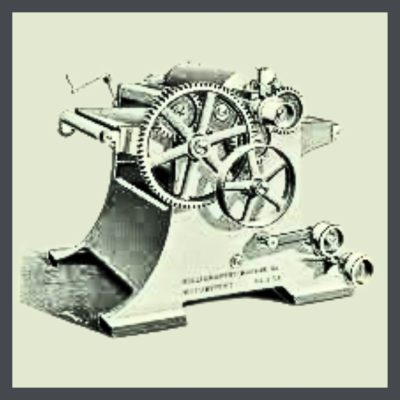 Once again, Eric’s words are in quotes. Mine are just there, unadorned, though, if I’m rudely interrupting him, you’ll see me in brackets.
Once again, Eric’s words are in quotes. Mine are just there, unadorned, though, if I’m rudely interrupting him, you’ll see me in brackets.
Rigging is the act of using equipment to lift or support a load. And when we’re talking a load here, many of these old machines weigh over a ton, like a small car.
Eric says, “… in order to bring home a machine to restore, I had to be able to move it. I was on a tight budget, so I had to learn how to do it by hand.”
Also, powered lift equipment simply would not fit into the mills or warehouses from which he removes equipment. Not to mention that the rotting floors he encounters, some of which have already collapsed, simply could not support the added weight.
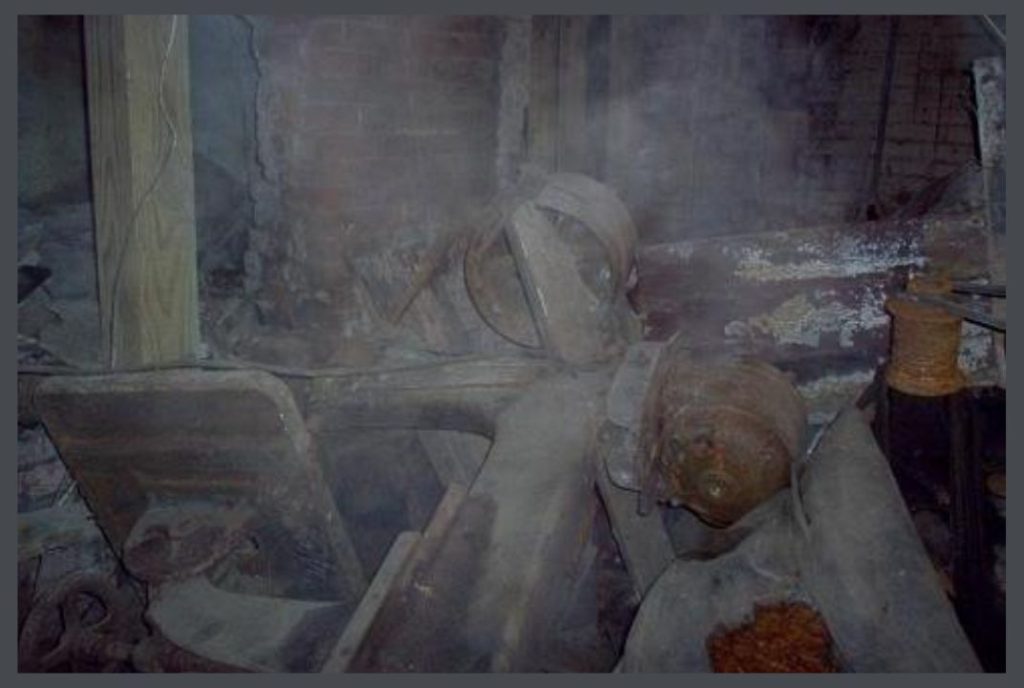
Machines piled in the basement. Their weight has caused the rotting floor under them to collapse.
“These techniques can often be incorporated into old house restoration when heavy stone or timbers need to be moved and placed.”
There is an elegant simplicity to each of these tools.
HOW TO MOVE RIDICULOUSLY HEAVY STUFF
Don’t try this at home, or anywhere, really!
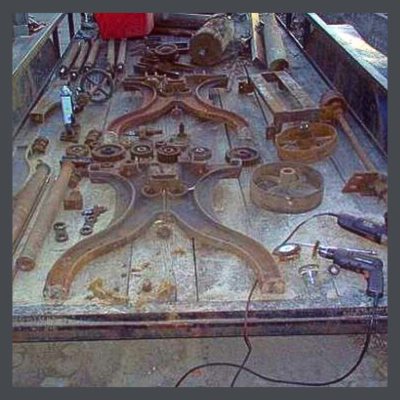
Drum sander moved out of a basement with no reasonable stairway by totally disassembling it.
“Sometimes a machine can be taken apart into much smaller, more manageable pieces if necessary. When I do that, I take an extensive number of pictures before and during disassembly.”
“…it’s really nice to have a second person to help. They don’t have to be big and strong, they just need to be able to place blocks or pipes as the machine is getting moved.
In fact, any attempt to lift this stuff by hand is really risky. A friend of mine who was in peak physical condition attempted to lift and pull a 2300lb piece of equipment, and ended up very sore and exhausted while the machine just sat still and laughed.”
Below are some images of some of Eric’s hand rigging tools. Please know that these are what he uses to move machines that weigh hundreds, even several thousand pounds each.
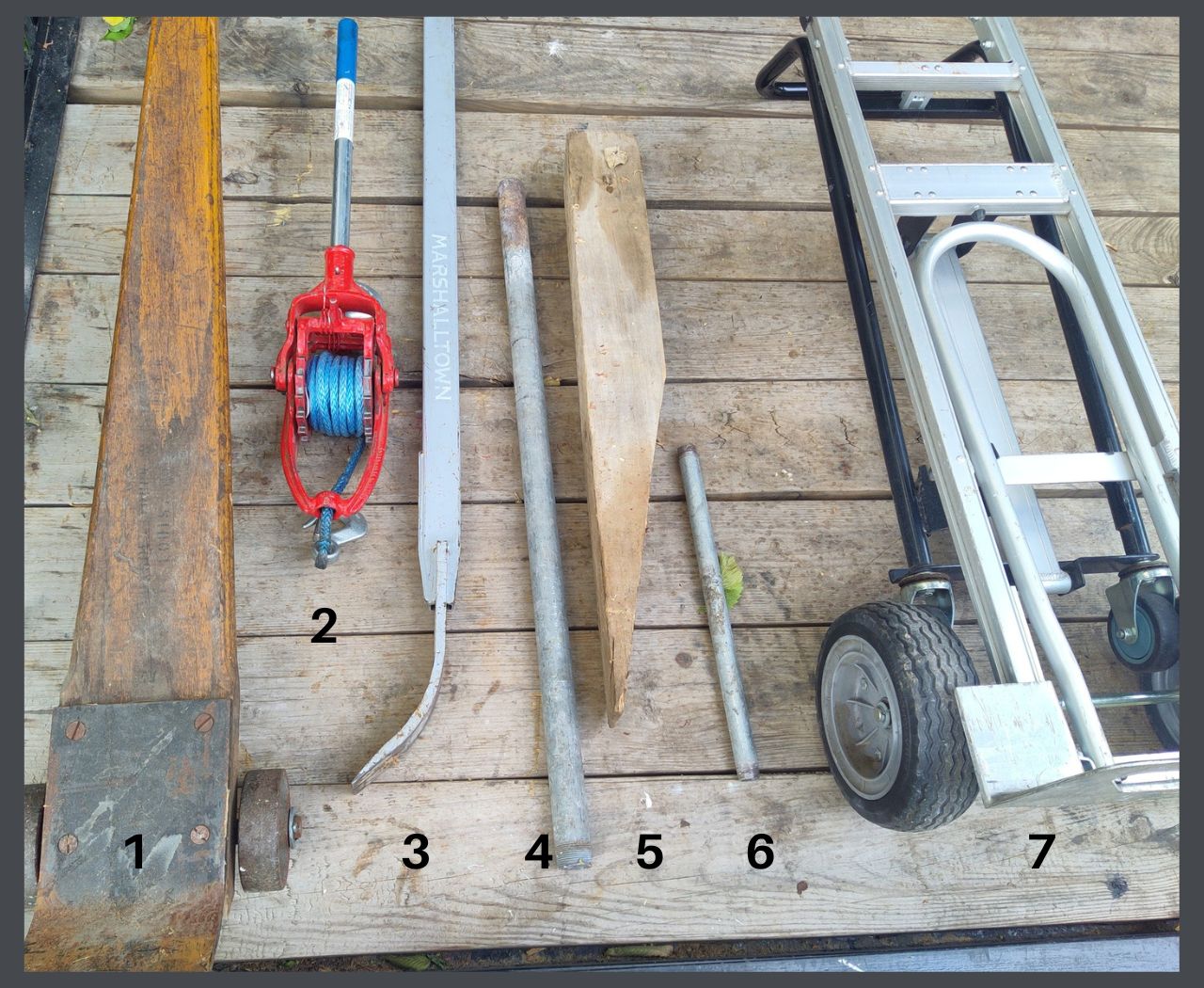
1. Johnson bar 2. Come-along hand winch 3. Burke bar 4. 1 1/4″ steel pipe 5. Long wedge 6. 3/4″ steel pipe 7. Regular 2-wheeled dolly.
“I’ve included a photo of some of my favorite hand rigging equipment: [Above]
1. Johnson bar or lever dolly, which will probably lift 5000lbs. [A Johnson bar helps provide leverage when needed to get underneath loads. The wheels provide a strong base, for secure leverage and safety.]
2. Come along/hand winch, a hand-operated winch [a hauling or lifting device such as this one] with a ratchet [a device with a wheel with teeth which allows motion in only one direction] used to pull objects. The drum [a cylindrical part of a machine] is wrapped with wire rope.
3. Long pry bar (specifically the Burke bar, which has become my favorite & can also probably lift 5000lbs)
4 and 6. Steel pipe in a couple different sizes. [Eric places these under the machines and rolls them along the floor and into whatever vehicle is waiting to transport them.] I’ve seen a machine that weighed 10 tons rolled through a building on a steel pipe, and the pipes did not crush. [Here’s a great story of a machine that was moved by the use of these steel pipes.]
5. A couple long wedges
6. A two wheeled dolly which is good for items under about 500lbs.
“Not pictured on the trailer deck are:
1. A chain hoist which will allow you to easily lift up to 5 tons. [You can see this handy little item in operation here.}
2. A low profile car jack which will lift 2 or 3 tons.
3. A pallet jack, which I call a poor man’s forklift and will lift 5500lbs for most models..
“I could probably buy this entire list on the used market for the price of renting a forklift for one day.
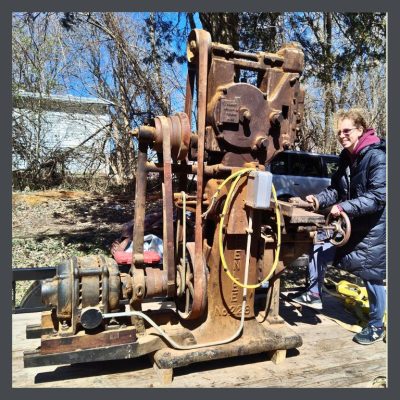
2200lb Greenlee 228 mortiser.
“The most difficult rig Claire and I have done is putting the 2200lb Greenlee 228 mortiser in the basement shop. We had to put it on 4×4 timbers with outriggers bolted to them for safety, unload it from the trailer, lay the machine face down with the chain hoist, lever it down two steps while going into a doorway, then stand it back up in the basement with a chain hoist.
“When we have to load a machine onto a trailer, we often strap it to a pallet jack and pull it up ramps with the hand winch. When a machine is on ramps, going either up or down, we wrap a large tie down strap once around the front of the trailer frame and tie it back to the machine. This allows us to instantly stop a machine with a light tug.
“To go across dirt or gravel, we lay a road of planks so the pipes or wheels stay on a firm surface. In a pinch, sometimes a simple 2×4 can be used as a lever. I’ve included a video Claire took where I was rotating a 1400lb planer with a 2×4.”
STAY IN THE BUNGALOW KNOW!!!
Sign up for our newsletter & receive our FREE E-book, 7 VITAL Things to Do Before You Hire a Contractor.




0 Comments